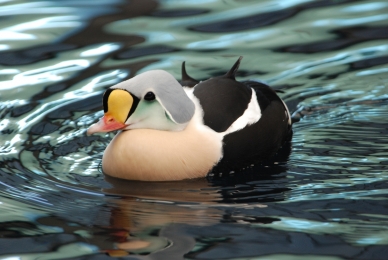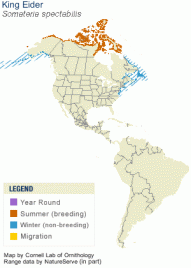Alaska Species Explorer
All
x
- – No known individuals remaining.
- – Known only to survive in captivity, or as a naturalized population outside its historic range.
- – Extremely high risk of extinction in the wild.
- – High risk of extinction in the wild.
- – High risk of endangerment in the wild.
- – Likely to become endangered in the near future.
- – Lowest risk. Does not qualify for a higher risk category. Widespread and abundant taxa are included in this category.
- – Not enough data to make an assessment of its risk of extinction.
- – Has not yet been evaluated against the criteria.
King Eider
- – No known individuals remaining.
- – Known only to survive in captivity, or as a naturalized population outside its historic range.
- – Extremely high risk of extinction in the wild.
- – High risk of extinction in the wild.
- – High risk of endangerment in the wild.
- – Likely to become endangered in the near future.
- – Lowest risk. Does not qualify for a higher risk category. Widespread and abundant taxa are included in this category.
- – Not enough data to make an assessment of its risk of extinction.
- – Has not yet been evaluated against the criteria.
Circumpolar; arctic parts of coastal Canada, Alaska, Siberia, Russia, Scandinavia, Greenland. Winters as far north as the seas remain relatively ice-free.
Although not a species of concern, population counts have indicated a decline in numbers. It is not confirmed whether this change in numbers represents population decline or change in distribution due to human disturbance. Migration counts at Point Barrow and indicators in Rasmussen Lowlands, NWT suggest population declines of up to 55%.
Distinctly different male and female breeding plumage. The male is black and white with a brightly colored head with light blue crown and nape, greenish face, and bright red-orange bill with large round orange knob outlined in black. The female is deep reddish brown, barred with black. Feathers on sides and flanks have black crescent or U-shaped black bars and dark centers.
Summer: Aquatic insect larvae, crustaceans, and plant matter. Winter: Mollusks, crustaceans, and echinoderms, as well as algae
Nests in various tundra habitats, generally in low marshy areas. Winters in marine environments near coastlines or on open water shallow enough to allow for foraging at the bottom.
- King Eiders have the shortest incubation period of any species of waterfowl
- Along with Common Eiders, King Eiders can also be found on the North East Coast
- When they molt in late August they go flightless for 40 days
-
The King Eider can dive up to 85 ft deep while it forages on sea beds















